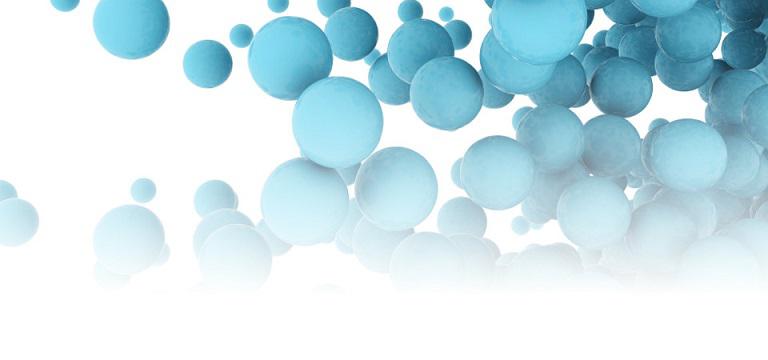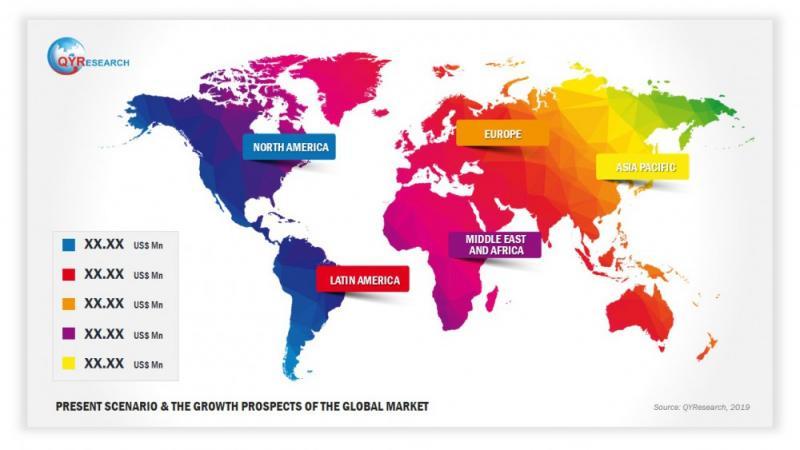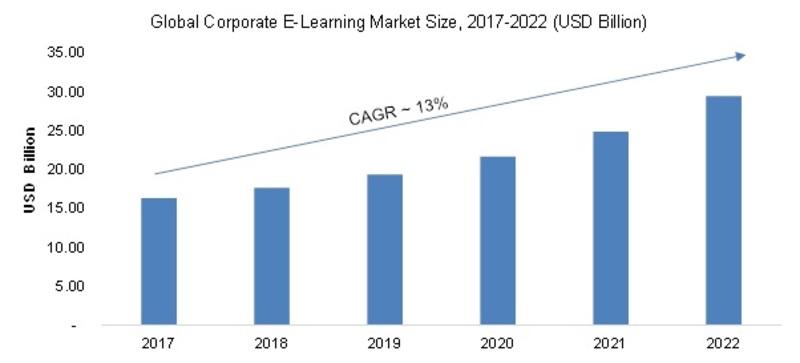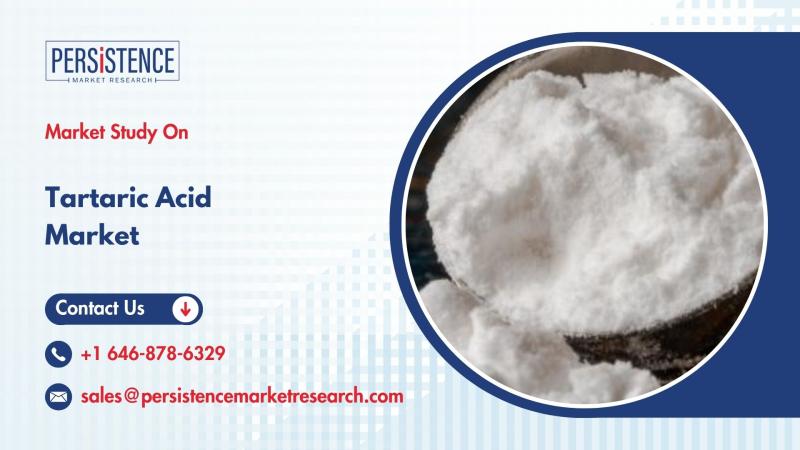Press release
Tartaric Acid Market to Achieve US$ 1.63 Bn by 2033 - Persistence Market Research
Introduction
The tartaric acid market has witnessed steady growth in recent years, primarily driven by its widespread applications in food & beverages, pharmaceuticals, cosmetics, and industrial sectors. Tartaric acid, a naturally occurring organic acid, is widely used as an acidulant, stabilizer, and antioxidant across various industries. With the growing demand for natural and clean-label ingredients, the market for tartaric acid is expected to expand significantly.
This report presents an in-depth analysis of the tartaric acid market, covering key growth drivers, challenges, market trends, technological advancements, and regional dynamics. The growing use of tartaric acid in winemaking, food processing, and pharmaceuticals is expected to boost market expansion over the forecast period.
Get a Sample PDF Brochure of the Report (Use Corporate Email ID for a Quick Response): www.persistencemarketresearch.com/samples/6811
Market Projections and Forecast
According to market projections, the global tartaric acid market is set for stable growth over the next decade. The market is expected to grow from an estimated value of USD 1,028.60 million in 2024 to USD 1,629.70 million by 2033, registering a compound annual growth rate (CAGR) of 5.20% during the forecast period.
The increasing demand for food additives, along with rising applications in pharmaceuticals and personal care products, is fueling this market expansion. Europe and North America are expected to maintain a dominant position, while Asia-Pacific is anticipated to experience the fastest growth due to increasing demand from the food and beverage sector.
Market Dynamics
Drivers of Market Growth
Growing Demand for Food & Beverage Additives:Tartaric acid is widely used in the food and beverage industry as an acidulant, preservative, and stabilizer. It plays a crucial role in maintaining the pH balance and improving the texture of various food products, including confectionery, baked goods, and dairy items. The rising demand for processed and packaged foods is significantly contributing to market growth.
Expansion of the Wine Industry:Tartaric acid is a key component in winemaking, as it helps regulate acidity levels and enhances flavor stability. With the increasing global consumption of wine, particularly in Europe and North America, the demand for tartaric acid is expected to rise steadily.
Rising Use in Pharmaceuticals and Personal Care Products:The pharmaceutical industry utilizes tartaric acid in drug formulations as a stabilizing and pH-adjusting agent. Additionally, its antioxidant and exfoliating properties make it a popular ingredient in skincare and personal care products. The growing focus on natural and organic cosmetics is further driving its adoption in the beauty industry.
Increasing Preference for Natural Ingredients:As consumer awareness of clean-label and natural ingredients rises, tartaric acid derived from natural sources such as grapes and tamarinds is witnessing higher demand. This trend is particularly prevalent in the food, beverage, and personal care industries, where consumers prefer plant-based alternatives to synthetic additives.
Challenges in the Market
Despite positive growth prospects, the tartaric acid market faces certain challenges:
Fluctuating Raw Material Prices:The primary sources of tartaric acid include grapes and tamarinds, which are subject to seasonal variations and supply chain disruptions. Fluctuations in raw material availability can impact production costs and market stability.
Stringent Regulatory Standards:The use of tartaric acid in food, pharmaceuticals, and cosmetics is subject to stringent regulatory approvals. Compliance with food safety and quality standards can pose challenges for manufacturers, particularly in regions with strict regulations like the European Union and the United States.
Competition from Synthetic Alternatives:While naturally derived tartaric acid is preferred, synthetic alternatives provide a cost-effective option for various industries. The availability of cheaper substitutes could limit the market penetration of natural tartaric acid.
Market Trends and Technological Innovations
Increasing Use of Tartaric Acid in Nutraceuticals:The rising popularity of functional foods and dietary supplements has led to greater utilization of tartaric acid in nutraceutical products. It acts as a stabilizer and enhances the bioavailability of key nutrients.
Sustainable and Eco-Friendly Production Methods:Manufacturers are increasingly focusing on sustainable production techniques, such as extracting tartaric acid from winemaking by-products. This approach reduces waste and aligns with global sustainability goals.
Expansion in Industrial Applications:Beyond food and pharmaceuticals, tartaric acid is also used in the construction industry as a retarder in cement and gypsum formulations. Its expanding industrial applications are contributing to overall market growth.
Growing Demand in Emerging Markets:Countries in Asia-Pacific and Latin America are witnessing increased demand for tartaric acid, driven by rapid urbanization, changing consumer preferences, and expanding food processing industries.
Tartaric Acid Market Segmentation
By Type:
Natural Tartaric Acid
Synthetic Tartaric Acid
By Application:
Food & Beverages
Pharmaceuticals
Personal Care & Cosmetics
Industrial Applications
By Source:
Grapes
Tamarinds
Chemical Synthesis
By Region:
North America
Europe
Asia-Pacific
Latin America
Middle East & Africa
Regional Analysis
Europe: Europe is expected to dominate the tartaric acid market, primarily due to its extensive wine production industry. Countries like Italy, France, and Spain are major consumers of tartaric acid for winemaking. The region's strong focus on clean-label food ingredients and sustainability also drives market growth.
North America: North America holds a significant share of the tartaric acid market, driven by high demand in the food, beverage, and pharmaceutical industries. The growing popularity of natural food additives and functional ingredients is supporting market expansion in the U.S. and Canada.
Asia-Pacific: Asia-Pacific is anticipated to witness the fastest growth, fueled by increasing consumption of processed foods, beverages, and pharmaceuticals. Rapid urbanization and industrialization in China, India, and Japan are key contributors to the rising demand for tartaric acid.
Key Companies Profiled in the Report
Distillerie Mazzari S.p.A.
Caviro Group
Merck KGaA
Omkar Specialty Chemicals Ltd.
Tarac Technologies
Industria Chimica Valenzana S.p.A.
ATP Group
American Tartaric Products Inc.
Changmao Biochemical Engineering Company Ltd.
Future Outlook
The future of the tartaric acid market is promising, with steady growth expected across multiple sectors. The increasing adoption of natural and sustainable ingredients, coupled with advancements in extraction and production technologies, will continue to drive market expansion. The demand for tartaric acid in winemaking, pharmaceuticals, and nutraceuticals is expected to remain strong, particularly in developed and emerging economies.
As industries continue to emphasize clean-label and eco-friendly solutions, the tartaric acid market will play a crucial role in supporting global trends toward natural and sustainable products.
Conclusion
The tartaric acid market is poised for sustained growth, driven by its versatile applications and increasing consumer preference for natural ingredients. Despite challenges such as raw material price fluctuations and regulatory constraints, the market's long-term outlook remains positive. With continued innovations and expanding industrial applications, tartaric acid will remain a key ingredient in various sectors, supporting its steady global demand.
Explore the Latest Trending "Exclusive Article" @
• https://prnewssync.medium.com/growth-trends-shaping-the-mixed-reality-market-919d9b66d291
• https://techxpresstoday.wordpress.com/2025/02/11/mixed-reality-market-emerging-technologies-and-innovations/
• https://apsnewsmedia.blogspot.com/2025/02/mixed-reality-market-investment.html
• https://www.manchesterprofessionals.co.uk/article/information-technology/82367/mixed-reality-market-size-analysis-and-industry-forecast
• https://vocal.media/stories/mixed-reality-market-adoption-in-healthcare-and-education
Contact Us:
Persistence Market Research
G04 Golden Mile House, Clayponds Lane
Brentford, London, TW8 0GU UK
USA Phone: +1 646-878-6329
UK Phone: +44 203-837-5656
Email: sales@persistencemarketresearch.com
Web: https://www.persistencemarketresearch.com
About Persistence Market Research:
At Persistence Market Research, we specialize in creating research studies that serve as strategic tools for driving business growth. Established as a proprietary firm in 2012, we have evolved into a registered company in England and Wales in 2023 under the name Persistence Research & Consultancy Services Ltd. With a solid foundation, we have completed over 3600 custom and syndicate market research projects, and delivered more than 2700 projects for other leading market research companies' clients.
Our approach combines traditional market research methods with modern tools to offer comprehensive research solutions. With a decade of experience, we pride ourselves on deriving actionable insights from data to help businesses stay ahead of the competition. Our client base spans multinational corporations, leading consulting firms, investment funds, and government departments. A significant portion of our sales comes from repeat clients, a testament to the value and trust we've built over the years.
The tartaric acid market has witnessed steady growth in recent years, primarily driven by its widespread applications in food & beverages, pharmaceuticals, cosmetics, and industrial sectors. Tartaric acid, a naturally occurring organic acid, is widely used as an acidulant, stabilizer, and antioxidant across various industries. With the growing demand for natural and clean-label ingredients, the market for tartaric acid is expected to expand significantly.
This report presents an in-depth analysis of the tartaric acid market, covering key growth drivers, challenges, market trends, technological advancements, and regional dynamics. The growing use of tartaric acid in winemaking, food processing, and pharmaceuticals is expected to boost market expansion over the forecast period.
Get a Sample PDF Brochure of the Report (Use Corporate Email ID for a Quick Response): www.persistencemarketresearch.com/samples/6811
Market Projections and Forecast
According to market projections, the global tartaric acid market is set for stable growth over the next decade. The market is expected to grow from an estimated value of USD 1,028.60 million in 2024 to USD 1,629.70 million by 2033, registering a compound annual growth rate (CAGR) of 5.20% during the forecast period.
The increasing demand for food additives, along with rising applications in pharmaceuticals and personal care products, is fueling this market expansion. Europe and North America are expected to maintain a dominant position, while Asia-Pacific is anticipated to experience the fastest growth due to increasing demand from the food and beverage sector.
Market Dynamics
Drivers of Market Growth
Growing Demand for Food & Beverage Additives:Tartaric acid is widely used in the food and beverage industry as an acidulant, preservative, and stabilizer. It plays a crucial role in maintaining the pH balance and improving the texture of various food products, including confectionery, baked goods, and dairy items. The rising demand for processed and packaged foods is significantly contributing to market growth.
Expansion of the Wine Industry:Tartaric acid is a key component in winemaking, as it helps regulate acidity levels and enhances flavor stability. With the increasing global consumption of wine, particularly in Europe and North America, the demand for tartaric acid is expected to rise steadily.
Rising Use in Pharmaceuticals and Personal Care Products:The pharmaceutical industry utilizes tartaric acid in drug formulations as a stabilizing and pH-adjusting agent. Additionally, its antioxidant and exfoliating properties make it a popular ingredient in skincare and personal care products. The growing focus on natural and organic cosmetics is further driving its adoption in the beauty industry.
Increasing Preference for Natural Ingredients:As consumer awareness of clean-label and natural ingredients rises, tartaric acid derived from natural sources such as grapes and tamarinds is witnessing higher demand. This trend is particularly prevalent in the food, beverage, and personal care industries, where consumers prefer plant-based alternatives to synthetic additives.
Challenges in the Market
Despite positive growth prospects, the tartaric acid market faces certain challenges:
Fluctuating Raw Material Prices:The primary sources of tartaric acid include grapes and tamarinds, which are subject to seasonal variations and supply chain disruptions. Fluctuations in raw material availability can impact production costs and market stability.
Stringent Regulatory Standards:The use of tartaric acid in food, pharmaceuticals, and cosmetics is subject to stringent regulatory approvals. Compliance with food safety and quality standards can pose challenges for manufacturers, particularly in regions with strict regulations like the European Union and the United States.
Competition from Synthetic Alternatives:While naturally derived tartaric acid is preferred, synthetic alternatives provide a cost-effective option for various industries. The availability of cheaper substitutes could limit the market penetration of natural tartaric acid.
Market Trends and Technological Innovations
Increasing Use of Tartaric Acid in Nutraceuticals:The rising popularity of functional foods and dietary supplements has led to greater utilization of tartaric acid in nutraceutical products. It acts as a stabilizer and enhances the bioavailability of key nutrients.
Sustainable and Eco-Friendly Production Methods:Manufacturers are increasingly focusing on sustainable production techniques, such as extracting tartaric acid from winemaking by-products. This approach reduces waste and aligns with global sustainability goals.
Expansion in Industrial Applications:Beyond food and pharmaceuticals, tartaric acid is also used in the construction industry as a retarder in cement and gypsum formulations. Its expanding industrial applications are contributing to overall market growth.
Growing Demand in Emerging Markets:Countries in Asia-Pacific and Latin America are witnessing increased demand for tartaric acid, driven by rapid urbanization, changing consumer preferences, and expanding food processing industries.
Tartaric Acid Market Segmentation
By Type:
Natural Tartaric Acid
Synthetic Tartaric Acid
By Application:
Food & Beverages
Pharmaceuticals
Personal Care & Cosmetics
Industrial Applications
By Source:
Grapes
Tamarinds
Chemical Synthesis
By Region:
North America
Europe
Asia-Pacific
Latin America
Middle East & Africa
Regional Analysis
Europe: Europe is expected to dominate the tartaric acid market, primarily due to its extensive wine production industry. Countries like Italy, France, and Spain are major consumers of tartaric acid for winemaking. The region's strong focus on clean-label food ingredients and sustainability also drives market growth.
North America: North America holds a significant share of the tartaric acid market, driven by high demand in the food, beverage, and pharmaceutical industries. The growing popularity of natural food additives and functional ingredients is supporting market expansion in the U.S. and Canada.
Asia-Pacific: Asia-Pacific is anticipated to witness the fastest growth, fueled by increasing consumption of processed foods, beverages, and pharmaceuticals. Rapid urbanization and industrialization in China, India, and Japan are key contributors to the rising demand for tartaric acid.
Key Companies Profiled in the Report
Distillerie Mazzari S.p.A.
Caviro Group
Merck KGaA
Omkar Specialty Chemicals Ltd.
Tarac Technologies
Industria Chimica Valenzana S.p.A.
ATP Group
American Tartaric Products Inc.
Changmao Biochemical Engineering Company Ltd.
Future Outlook
The future of the tartaric acid market is promising, with steady growth expected across multiple sectors. The increasing adoption of natural and sustainable ingredients, coupled with advancements in extraction and production technologies, will continue to drive market expansion. The demand for tartaric acid in winemaking, pharmaceuticals, and nutraceuticals is expected to remain strong, particularly in developed and emerging economies.
As industries continue to emphasize clean-label and eco-friendly solutions, the tartaric acid market will play a crucial role in supporting global trends toward natural and sustainable products.
Conclusion
The tartaric acid market is poised for sustained growth, driven by its versatile applications and increasing consumer preference for natural ingredients. Despite challenges such as raw material price fluctuations and regulatory constraints, the market's long-term outlook remains positive. With continued innovations and expanding industrial applications, tartaric acid will remain a key ingredient in various sectors, supporting its steady global demand.
Explore the Latest Trending "Exclusive Article" @
• https://prnewssync.medium.com/growth-trends-shaping-the-mixed-reality-market-919d9b66d291
• https://techxpresstoday.wordpress.com/2025/02/11/mixed-reality-market-emerging-technologies-and-innovations/
• https://apsnewsmedia.blogspot.com/2025/02/mixed-reality-market-investment.html
• https://www.manchesterprofessionals.co.uk/article/information-technology/82367/mixed-reality-market-size-analysis-and-industry-forecast
• https://vocal.media/stories/mixed-reality-market-adoption-in-healthcare-and-education
Contact Us:
Persistence Market Research
G04 Golden Mile House, Clayponds Lane
Brentford, London, TW8 0GU UK
USA Phone: +1 646-878-6329
UK Phone: +44 203-837-5656
Email: sales@persistencemarketresearch.com
Web: https://www.persistencemarketresearch.com
About Persistence Market Research:
At Persistence Market Research, we specialize in creating research studies that serve as strategic tools for driving business growth. Established as a proprietary firm in 2012, we have evolved into a registered company in England and Wales in 2023 under the name Persistence Research & Consultancy Services Ltd. With a solid foundation, we have completed over 3600 custom and syndicate market research projects, and delivered more than 2700 projects for other leading market research companies' clients.
Our approach combines traditional market research methods with modern tools to offer comprehensive research solutions. With a decade of experience, we pride ourselves on deriving actionable insights from data to help businesses stay ahead of the competition. Our client base spans multinational corporations, leading consulting firms, investment funds, and government departments. A significant portion of our sales comes from repeat clients, a testament to the value and trust we've built over the years.
Permanent link to this press release:
Copy
Please set a link in the press area of your homepage
to this press release on woodPRI. woodPRI disclaims liability for any content contained in
this release.
Recommend

/newsMicroencapsulation Market Deep Analysis on Key Players - Dow Corning, Encapsys, Syngenta Crop Protection, Evonik Industries, 3M and Bayer
Market Study Report Adds Global Microencapsulation Market Size, Status and Forecast 2024 added to its database. The report provides key statistics on the current state of the industry and other analytical data to understand the market.
Extensive research is required for choosing the appropriate cor...

/newsGermany Airbag Market Size 2023: Global Share, Industry And Report Analysis By 2030 | Hyundai Mobis Co., Ltd. Key Safety Systems, Inc. Robert Bosch GmbH
Germany airbag market is expected to grow at a CAGR of around 6% during the forecast period. Germany Airbag Market research report refers to gathering and analyzing significant market data serve as best medium for various industry players to launch novel product or service. It is vital for key firms...

/newsSecurities Brokerages And Stock Exchanges Market Outlook 2021: Big Things are Happening
A new intelligence report released by HTF MI with title "Global Securities Brokerages And Stock Exchanges Market Survey & Outlook" is designed covering micro level of analysis by Insurers and key business segments, offerings and sales channels. The Global Securities Brokerages And Stock Exchange...

/newsRenewable Chemicals Market Emerging Trends and Competitive Landscape Forecast to 2028
The renewable chemicals market was valued at US$ 80,566.30 million in 2021 and is projected to reach US$ 1,76,750.76 million by 2028 it is expected to grow at a CAGR of 11.9% from 2021 to 2028. The research report focuses on the current market trends, opportunities, future potential of the market, a...

/newsHow Coronavirus is Impacting Cold Brew Coffee, Global Market Volume Analysis, Size, Share and Key Trends 2020-2026
"Market Latest Research Report 2020:
Los Angles United States, February 2020: The Cold Brew Coffee market has been garnering remarkable momentum in the recent years. The steadily escalating demand due to improving purchasing power is projected to bode well for the global market. QY Research's lates...

/newsCorporate E-Learning Market - Global Industry Size, Share, Key Players Analysis that are Infor, SkillSoft Corporation, Adrenna, CERTPOINT Systems and others with Regional Forecast to 2022
Overview:
E-Learning is used to enhance the learning procedures for newer job requirements and to make employees sound about the internal and external changes in the market and respective organizations. This method has created considerable differences in the ways of training and developing employee...
